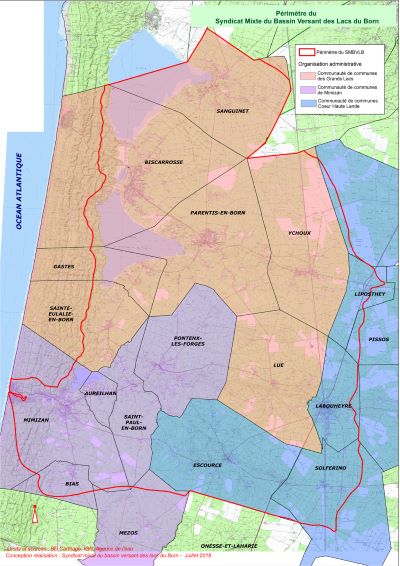

The Syndicat mixte du bassin versant des lacs du Born (SMBVLB - Born lakes governance body) was created by the prefectoral decree on 9 April 2014 and has been effective since 1 July 2014.
The competences of the SMBVLB relate to the management and maintenance of waterways, and the animation of the implementation phase of the SAGE:
- carrying out studies, project management missions, monitoring, coordination and advice, for the management of aquatic environments in its territory
- animation of the implementation phase of the SAGE Etangs littoraux Born et Buch
- animation, advice/technical support, coordination and awareness-raising with institutions, collectivities and users for the implementation of the SAGE and the PPGCE (Programme Pluriannuel de Gestion des Cours d’Eau - Multiannual Programme for River Management) , in particular through the development of educational materials and actionsacquisition and dissemination of knowledge on aquatic environments
- acquisition and dissemination of knowledge on aquatic environments
Website: https://www.sage-born-et-buch.fr/
TERRITORY

- Surface area: 1 121km² (SMBVLB) et 1 490 km² pour le SAGE
- River basin district : Adour-Garonne
- Number of SAGE supported: 1
- SAGE involved in the LIFE Eau&Climat project: SAGE Etangs littoraux Born et Buch
- Other management tools concerned by the project:
- PPGCE (Programme Pluriannuel de Gestion des Cours d’Eau - Multiannual Programme for River Management)
- DOCOB Natura 2000
- PCAET (Plan Climat Air Energie Territorial - planning tool that aims to mitigate climate change, develop renewable energy and control energy consumption)
- ...
- The territory’s issues concerning the climate change:
- water management
- uses including tourism
- biodiversity
CONTRIBUTION AT THE LIFE EAU&CLIMAT PROJECT
SMBVLB is particularly involved in the following actions:
- Development and validation of decision support tools -> expectations, recommendations, demonstration and validation of tools
- Mobilisation of local stakeholders -> conducting a prospective study to define a strategy for adaptation to climate change at the local level
- Facilitating access to hydro-climatic data -> specification of needs in terms of data and indicators
- Strengthen exchanges between researchers and managers -> development of a modelling tool adapted to coastal water bodies
- Strengthen exchanges between researchers and managers -> development of a modelling tool adapted to coastal water bodies
